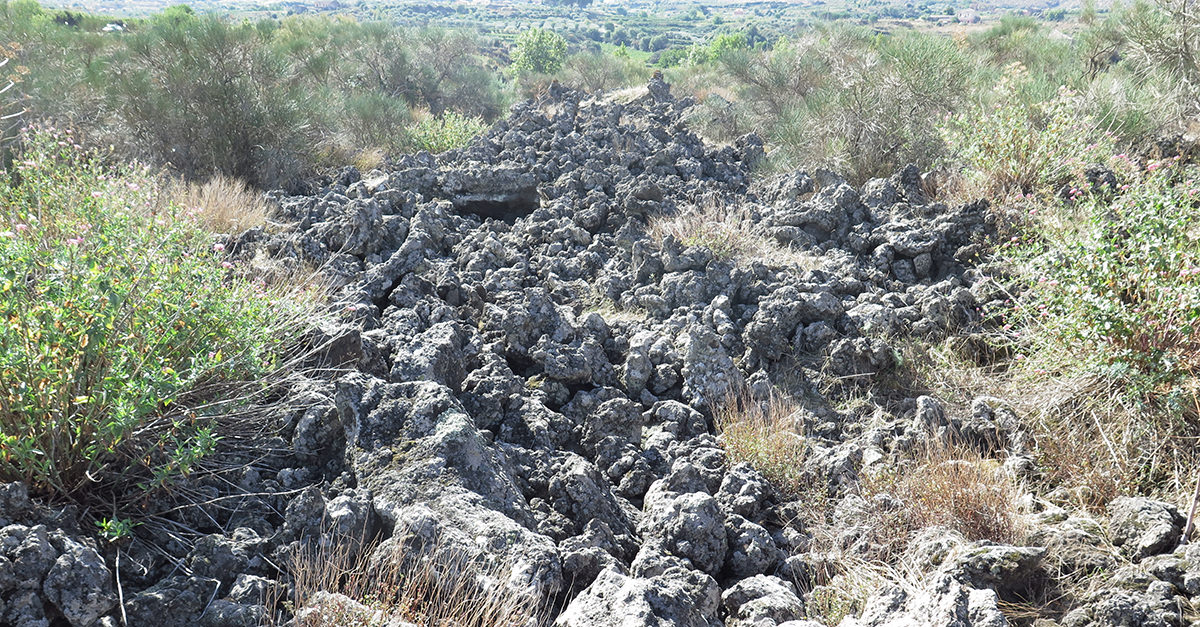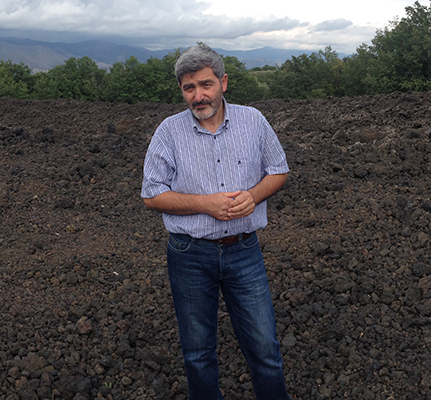
If you’ve ever heard your local retailer, or sommelier, rhapsodize about a wine that’s made in “volcanic soil,” and wondered why that matters, there’s one place on earth that can probably help you understand: Mount Etna. This active volcano in the northeast corner of Sicily (just off the tip of Italy’s boot) erupted earlier this month – its most dramatic eruption in about twenty years. A four-mile-high ash column rose into the starry night sky, and lava spewed everywhere. It was a spectacular sight – fortunately, no deaths were reported – and it’s also the reason why wines from Mount Etna are so delicious and special.
The Etna DOC (denominazione di origine controlatta) was established in 1968, making it one of Sicily’s first. The DOC area does not go all the way up the mountain, and some great vineyards are excluded because they are too high up – just one of those appellation politics things that aggravates winemakers to no end.
The Contrada system in Sicily, which was officially adopted in 2011, indicates special terroir, where a place is named to recognize its character and historical significance. Many places on Etna have old vines (80 or even 100 years-old), and there are various microclimates, the result of individual eruptions and lava flows.

During a visit to Sicily hosted by Planeta winery, I learned about Etna’s history with a volcanologist, Palmiro Mannino, who grew up in a small town literally in the shadow of the volcano. According to Mannino, it’s not actually the lava deposit that affects vines (and the wines made from them); rather, it’s the ash. Volcanic ash is porous, and it mixes with rocks, creating a hospitable environment for plants to absorb water through their roots. The lava flows fill the ashy soil with nutrients such as magnesium, calcium, sodium, iron, and potassium.
On Etna, red wines are made mostly of Nerello Mascalese, a tannic and earthy grape with aging potential, and a bit of Nerello Cappuccio. Whites are principally Carricante, an elegant grape with natural acidity and floral notes, as well as Catarratto.
Here are some excellent bottles from Etna to try.
Passopisciaro, 2011 $38
From looking at one of these bottles, it is difficult to tell what’s going on here. Besides the vintage, the fact that it’s from Sicily, and either the word “Passopisciaro” or “Contrada,” there’s no other information. Perhaps winemaker Andrea Franchetti expects his fame to precede him, assuming that drinkers will know his red wines are from Mount Etna and therefore are made principally of the Nerello Mascalese grape. Franchetti’s Etna wines are bold, structured and vibrant. The 2011s are drinking particularly well right now.
Planeta “Etna Bianco, 2014 $18
This is a great example of affordable, delicious Etna Bianco, in this case made from 100 percent Carricante. Planeta is one of Sicily’s larger wineries, but it is family-owned and–operated, and devoted to producing terroir-driven wines. The acidity of Carricante makes for a lively and fresh wine, and it’s also very aromatic, with a nose of wet grass, sand, and lemon curd. The finish is mineral, almost like Chablis. Try this wine with smoky foods, like porcini mushrooms, which are a seasonal Sicilian delicacy, and floral notes will emerge.
Frank Cornelissen “Contadino,” $29
If you’re curious about natural wines, try this unfiltered, whole cluster–fermented (meaning, stems and skins and all), unsulfured (no preservatives added) bottle by a Belgian winemaker, who started producing in Sicily in the early 2000s. Not for the conservative drinker, Cornelissen’s pricey and enigmatic wines have intense flavor profiles, usually high in acidity. They are also cloudy and full of sediment, due to the lack of filtering. Cornelissen’s non-interventionist approach to winemaking also means that there is a lot of bottle variation, meaning some bottles will be funkier than others, and may even be re-fermenting, which can happen when a wine has live bacteria. But if you get an excellent bottle, you may be converted to natural wine for good. His entry-level wine is a lush red blend, primarily Nerello Mascalese, called Contadino.
Quantico “Etna Bianco,” 2012, $32
Like the wines of Frank Cornelissen, these wines are sulfur-free, but they aren’t necessarily funky. Quantico’s Etna Bianco is a fresh and lively bottle, made of 70 percent Carricante, 20 percent Catarratto, and 10 percent Grillo (another indigenous Sicilian grape). There’s that minerality that speaks to the volcanic soil on Etna, as well as the relentless winds, which protect the grapes from ripening too much in the hot Sicilian sun by preserving acidity. Try this one with shellfish or pasta.
A few other Etna wine producers to seek out:
- Benanti: look for Pietra Marina Etna Bianco
- Calabretta: old-vines Etna Rosso that ages particularly well
- Tenute Terre: beautiful wines from old vineyards, at great value
